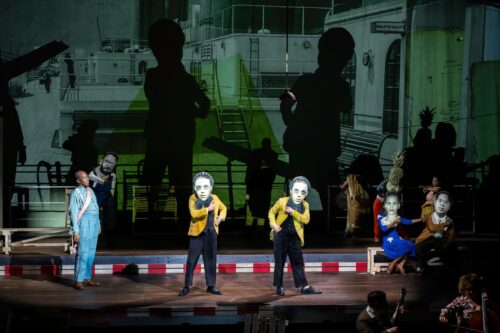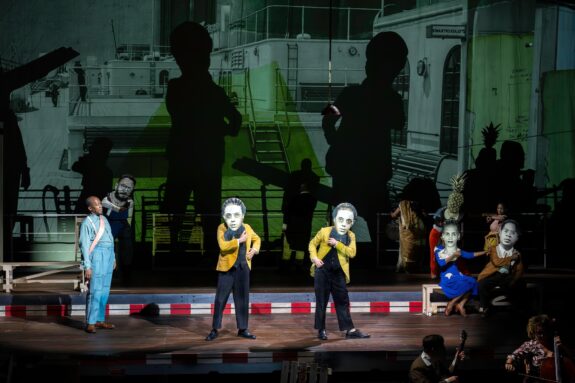 United States William Kentridge, The Great Yes, The Great No: The Wallis Annenberg Center for the Performing Arts, Beverly Hills, 6.2.2025. (JRo)
United States William Kentridge, The Great Yes, The Great No: The Wallis Annenberg Center for the Performing Arts, Beverly Hills, 6.2.2025. (JRo)

Dada was a revolutionary art and literary movement created in response to the horrors of World War I and the rapid industrialization of the early-twentieth century. William Kentridge, the twenty-first century’s premier Dadaist of paper, sculpture and performance, uses modern technology to explore political questions of race, colonialism and the planet’s desecration. Set before a backdrop of video projections, the words, images, music and dance conspire to create a uniquely, over-the-top, Kentridge-esque experience.
To be at a Kentridge event – whether grand opera, such as his staging of The Nose or Lulu, or a smaller scale performance, such as The Refusal of Time (also known as Refuse the Hour), or this current production of The Great Yes, The Great No (the title taken from a poem by Greek poet Constantine Cavafy) – is to enter a spinning world of music, dance and drama. Dada-esque figures romp in costumes and masks reminiscent of the hi-jinks at the Cabaret Voltaire, a Swiss nightclub where Dada was born.
The work is set on a cargo ship escaping Vichy France for Martinique, and the passenger list includes such luminaries as Frantz Fanon, André Breton, Trotsky, Frida Kahlo, Diego Rivera, Joséphine Bonaparte (born in Martinique), Josephine Baker (the political activist and performer) and authors Suzanne Césaire and Anna Seghers. Actors dance behind oversized, black-and-white masks that sport photos of the various players and dwarf their bodies. With the whimsical interplay of scale, they resemble caricatures come to life.
The master of ceremonies and captain of the ship is Charon (Hamilton Dhlamini), the ferryman of dead souls. With the confidential air of a charming party guest, Charon introduces the company, cajoles the audience and comments on the plight of the world. It is a world destined to repeat its mistakes, and there is a sense of inevitability about everything that happens onstage.
But the feeling of a doomed world is tempered by the uplifting music, particularly the choral compositions of the multi-talented Nhlanhla Mahlangu. Traditional African music, call and response, liturgical strains and snippets of jazz were sung with a pure and graceful vocal style by an extraordinary chorus of seven women. Whether a cappella or accompanied by a gifted ensemble of musicians on piano, cello, banjo, accordion and percussion, their voices expressed determination to throw off the yoke of the oppressor.
The libretto, drawing from Aimé Césaire’s Cahier d’un retour au pays natal (Notebook of a Return to the Native Land), includes phrases from works by Bertolt Brecht, André Breton, Wifredo Lam, Suzanne Césaire, Léon-Gontran Damas, Frantz Fanon and more, oftentimes projected on the backdrop in an interplay of text and art. The spirits of Bertolt Brecht and Kurt Weill hovered over the performance – they were committed partners in the use of theatre to change minds and hearts.

As for Kentridge’s visual gymnastics, video projections on a massive backdrop featured prominently in the work. Film, photos and drawings rendered the machinery of ships, tropical vegetation, constellations, concentric circles on which text appeared and a short video of a mad tea party (mad coffee party might be closer to the mark) where sat tuxedoed and gowned guests wearing coffeepot head masks (a symbol of colonialism?). Masks of fish heads, bird heads and a lone pineapple head added a touch of the natural world.
My personal favorites were the stiff, pleated, paper costumes on dancers Thulani Chauke and Teresa Phuti Mojela. Oscar Schlemmer’s Triadic Ballet was a seminal Bauhausian work, and Kentridge channels Schlemmer’s costumes and his use of scale and materials to create dancing, living sculptures. Kentridge’s brand of fun is never far away and leavens his politically charged subject matter.
Peppered throughout the drama were the recitations of the elegant Nancy Nkusi – her voice more like the whisper of bird wings than human speech. William Harding and Neil McCarthy enacted the Chaplinesque figures of Hitler, Vichy military men and white oppressors from any totalitarian regime.
Circling back to the opening of The Great Yes, The Great No, the following lines can certainly be repeated in every generation: ‘Where you come from, you will not be missed; where you are going you will not be welcome’. Once again, Kentridge’s art is as relevant as today’s news.
Jane Rosenberg
Cast:
Performers – Xolisile Bongwana, Hamilton Dhlamini, William Harding, Neil McCarthy, Tony Miyambo, Nancy Nkusi
Chorus – Anathi Conjwa, Asanda Hanabe, Zandile Hlatshwayo, Khokho Madlala, Nokuthula Magubane, Mapule Moloi, Nomathamsanqa Ngoma
Dancers – Thulani Chauke, Teresa Phuti Mojela
Musicians – Marika Hughes (cello), Nathan Koci (accordion and banjo), Tlale Makhene (percussion), Thandi Ntuli (piano)
Production:
Concept & Direction – William Kentridge
Libretto – Jessica Jones
Associate directors – Nhlanhla Mahlangu, Phala O. Phala
Choral composer – Nhlanhla Mahlangu
Music director – Tlale Makhene
Sets – Sabine Theunissen
Costumes – Greta Goiris
Choreography – Thulani Chauke, Teresa Phuti Mojela
Lighting – Urs Schönebaum, Elena Gui
Projection editing & Compositing – Žana Marović, Janus Fouché, Joshua Trappler
Cinematography – Duško Marović
Video control – Kim Gunning
Sound – Gavan Eckhart
Dramaturg – Mwenya Kabwe
